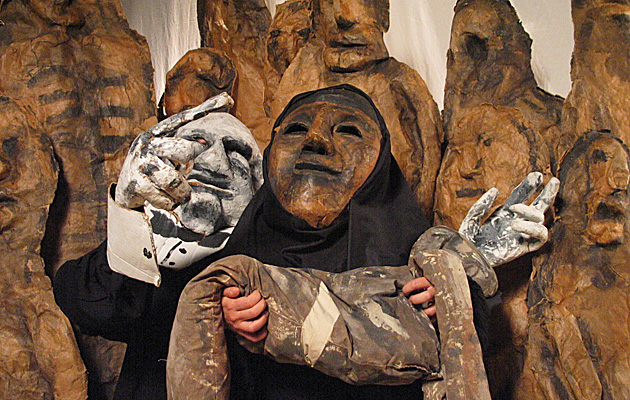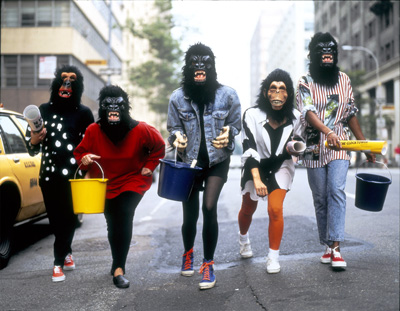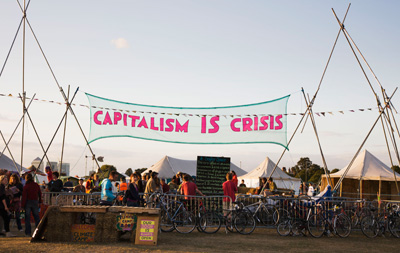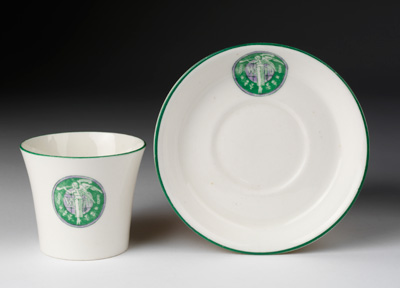|
Puppets from the radical Vermont-based Bread and Puppet Theater |
||
|
The raw anger, energy and wit of protest comes to genteel South Kensington. Alice Bell finds it most refreshing If you enter the Victoria and Albert Museum through its main entrance on Cromwell Road, you may spot the word cunt built into a mosaic fashioned from photographs of protests. Look hard, and there’s the word twat too. It’s not graffiti, it’s art, and Disobedient Objects, the exhibition this artwork announces, is quite remarkable, even without dropping the c-bomb. Remarkable because it is so well designed, surprising, engrossing and, simply, fun. But also remarkable because the topic – the artefactual nature of protest – is too often ignored. Although the V&A recently made headlines around the world when it chose to include anti-homeless spikes in its Rapid Response Collecting gallery, Disobedient Objects takes the topic of social exclusion and design a step further.
Guerilla Girls, the group of women artists who, in 1985, set out to expose racism, sexism and corruption in the art world The exhibits on display are perhaps more objects for disobedience, rather than disobedient objects. But that’s no bad thing, especially as it accomplishes a richer, more challenging display than last year’s disappointing Art Turning Left: 1789-2013 at Tate Liverpool. A large banner declaring “Capitalism IS crisis” in green and pink looms over the gallery from the ceiling. Made for the 2009 Blackheath Climate Camp, you may remember it from the 2011 Occupy camp outside St Paul’s too, and it may yet return to the streets again. As a sign notes, some of the displays are objects of ongoing struggles.
Capitalism is Crisis banner at Blackheath A talking head on a large TV screen at the end of the gallery remarks that “When we look at history, it’s all too often written from the perspective of the victors.” And this is key to why this exhibition is so surprising, especially at the V&A. Like most of the institutions of South Kensington, the V&A is a product of the Great Exhibition, a rather unquestioning celebration of the world the Victorians built us, with little sense that life could be different, and little reflection of the various groups and alternative ideas for society that were steamrollered over – sometimes literally – to get there. But, steamrolled over or not, a history of lock-ons and the Capitalism is Crisis banner are as much part of modernity as a gallery of wedding dresses. Their arguments are part of the hard tissue of our world, even if we don’t always recognise it. As are the history of the pink triangle, a collection of anti-apartheid badges and a simple poster-paint-and-cardboard banner that declares “I wish my boyfriend was as dirty as your policies”, all also displayed in the gallery. It’s not complete – there are many protest movements missing – but it’s diverse and engaging.
A 2011 placard by Coral Stoakes My favourite exhibit is a tiny resistor from a Polish radio, turned into a Solidarnosc badge. A play on the word resistance, it’s also a nod to the radio they communicated with. As with several exhibits, I wondered if this resistor might be better presented in the Science Museum, or at least it would have been interesting to develop the ideas in contexts
Women’s Social and Political Union china teaset As you leave, there’s a sign pointing out that the gallery doors illustrate a history of the changing design of barricades and blockades – a very different type of object for disobedience which, as the label notes, has still played a key role in the history of social movements. Taking inspiration from this, and considering some of the gaps in Disobedient Objects, perhaps the Science Museum could be tempted to follow the V&A’s lead and offer us an exhibition on technologies of political control? |
Words Alice Bell
Images: Victoria & Albert Museum
Disobedient Objects |
|
|
||
























